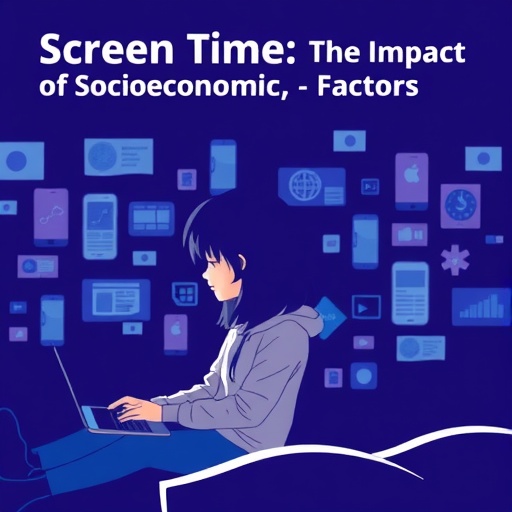In an era where screens are increasingly omnipresent in our daily lives, the research spearheaded by H. Değerli and K.S. Budak Topaloğlu titled “Little Eyes on Screens: Understanding Socioeconomic Factors in Screen Time,” published in the Journal of Child and Family Studies, provides critical insights into how varying socioeconomic backgrounds influence children’s screen time. This ever-relevant issue merits attention as the implications extend beyond individual behavior, filtering into public policies, educational strategies, and parental guidance.
The significance of this research lies not merely in the recording of screen time but in contextualizing it through the lens of socioeconomic variables such as income levels, parental education, and access to technology. These factors frame the degrees of exposure that children have to screens, raising vital queries about the digital divide that inherently affects learning opportunities and health outcomes. Children from lower-income families might find themselves in a heavier reliance on screens for entertainment or educational resources, while those from wealthier backgrounds might have access to a richer array of structured activities.
As screen time accelerates, particularly given the rise of mobile devices and tablets, the nuances of its usage become pivotal. Değerli and Budak Topaloğlu delve into the multifaceted nature of screen time. They differentiate between recreational use and educational engagement, positing that not all screen time is created equal. While some usage may directly contribute to learning and cognitive skills, excessive recreational use might tether academic performance and mental well-being to unexpected lows.
Crucially, the research highlights how societal perceptions of screen time can inadvertently shape parental attitudes and decisions. For families in communities with higher socioeconomic status, there might be a trend toward limiting screen time, advocating for a well-rounded approach to childhood development. Conversely, parents in resource-limited environments may not have the luxury to impose such restrictions, which could lead to a range of coping mechanisms driven by necessity rather than preference.
Emerging from their empirical analysis, the authors underscore the role of education as a powerful predictor in managing screen time effectively. Parents with higher educational accomplishments tend to exhibit greater awareness of the ramifications of prolonged screen exposure. Through this lens, the researchers advocate for educational interventions tailored to equip all families, regardless of socioeconomic status, with the knowledge to navigate the digital landscape effectively.
In addition to parental education, the access and quality of technology play a fundamental role in shaping children’s screen experiences. The quality of content and its appropriateness for age groups often correlate with the types of screens children engage with. Public policies must consider how to subsidize quality educational resources for disadvantaged families, effectively bridging the inequality gap that tech access creates. An investment in robust digital literacy programs can empower vulnerable communities and enhance children’s engagement with technology in a healthy manner.
Furthermore, with the omnipresence of screens, the challenge remains in discerning whether children are merely passive consumers or active participants in a digital playground. The research addresses the implications of passive consumption, which can foster addictive behaviors detrimental to mental health. As children succumb to the lure of constant engagement, parents must grapple with the challenge of fostering balance and moderation without alienating their children from the dominant culture of technology.
Despite the obstacles, the authors believe that a proactive approach can yield significant benefits for child development. They emphasize the necessity for creative parental strategies that acknowledge digital consumption while actively incorporating it into family life. This synthesis could mean channeling screen time into collaborative family activities that foster interaction, education, and relationship-building, thus transcending the traditional boundaries that screens create.
The study peeks into the future, proposing what is often lacking in the current discourse: the need for continuous engagement with researchers, educators, and families to cultivate a more sustainable approach for integrating technology into young lives. It becomes evident that the conversation surrounding screen time should evolve beyond mere data collection into actionable frameworks capable of influencing policy changes and educational standards.
In conclusion, the research conducted by Değerli and Budak Topaloğlu spearheads an essential conversation on screen time and its intricate ties to socioeconomic factors. As technology continues to be interwoven into the very fabric of society, the dialogue must pivot towards addressing disparities, promoting equitable access, and fostering healthy technological interactions among children. The importance of their findings aligns with contemporary calls for holistic approaches to child welfare in the digital age.
Ultimately, the time has come for policymakers, educators, and society at large to heed the findings of this pivotal research. Children today are the digital citizens of tomorrow, and how we guide them through their screen interactions will shape not only their educational outcomes but also their mental health and societal engagement as they grow.
Subject of Research: Socioeconomic factors influencing children’s screen time.
Article Title: Little Eyes on Screens: Understanding Socioeconomic Factors in Screen Time.
Article References:
Değerli, H., Budak Topaloğlu, K.S. Little Eyes on Screens: Understanding Socioeconomic Factors in Screen Time.
J Child Fam Stud (2025). https://doi.org/10.1007/s10826-025-03227-4
Image Credits: AI Generated
DOI:
Keywords: Screen Time, Socioeconomic Factors, Child Development, Digital Literacy, Education, Technology Access




